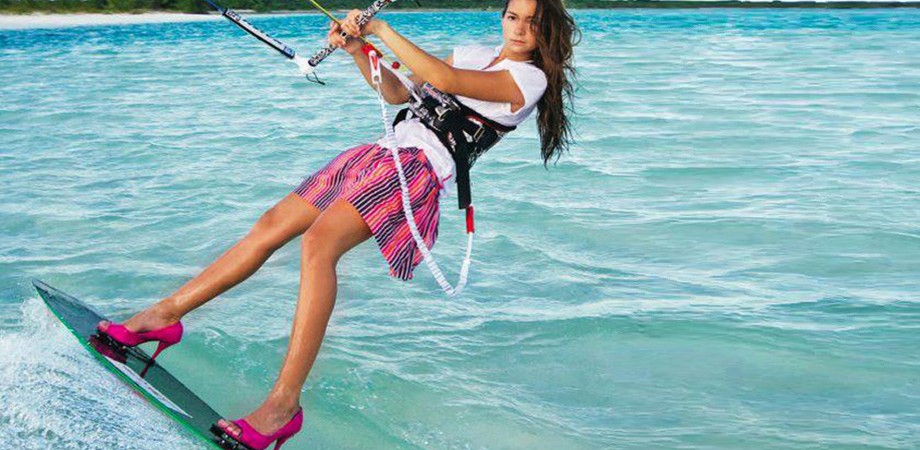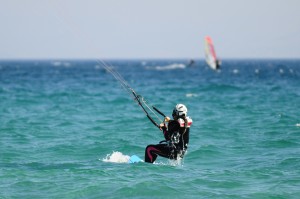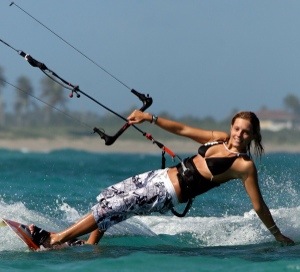
Riding upwind is in many ways the Holy Grail of kitesurfing. The ability to leave the beach and come back at the same point, avoiding the Walk of Shame in the process is what marks out those who can sit in the pub and proudly announce to potential romantic interests, “I kitesurf,” from those who are still learning and sit there quietly for fear of being found out the next day at the beach if they speak up.
It is in many ways a very natural process.
As you become comfortable with your first rides and start extending the distance you are riding you will naturally start to transfer your weight to your back foot. This is a natural process as you’ll naturally want to engage the edge to give the board some more stability and, once achieved, it is a much more comfortable riding position.
The big problem here is that as you still don’t quite have the balance/counter balance of the kite worked out you will often transfer too much weight on to the back foot, which engages the heel side edge too much, causing the board to screw upwind, braking it and leaving you sinking.
Or you don’t engage the edge enough or engage it at the wrong angle and end up skidding off down wind totally out of control until an amused Neptune takes you out of you misery and provides a nice wave for you to trip over and come crashing down in a splash.
Embrace the suck and learn to love it, this is an essential part of learning to ride upwind.
As you start to learn how much power is coming through the kite you will start to transfer that power through your back heel into the board in a controlled manner and that will start to turn the board upwind avoiding the pitfalls mentioned above.
Aside from just letting nature take its course there are (of course) some things we can do to help the process along the way.

The first one is to…
Look Where You Are Going.
To start with your attention will be focused entirely on the kite, that’s natural. As soon as you feel you are able, start to transfer your attention and your eyes away from the kite and look upwind at the point you want to arrive at. As soon as you can do this with any sort of consistency you’ll start to notice results.
By looking at your destination you start to open up your shoulders and hips, transferring your weight correctly automatically, much like on a snowboard.
Try it now, stand up now with your legs spread shoulder width apart, shoulders facing forward. Now turn your head 90 degrees to the right and let your shoulders follow, notice where the weight is transferred to.
If you’ve done it correctly and opened up your shoulders and hips you should notice that your left heel is now much more firmly planted on the ground and the weight has transferred from your right foot into this left heel.
This is exactly the effect we are looking for in our kitesurfing. To transfer enough weight onto that back heel thereby engaging the edge and starting to drive ourselves up wind.
The key to this is to think in terms of what your shoulders (and hips) are doing and not what your feet are doing. i.e. don’t try and drive more weight through your heel, let your stance do the work for you.
Get The Bar Out
For many people as soon as they are riding the first thing they do is pull the bar all the way in for security…it feels good to have some thing to hold on to tight! By doing this you are effectively choking the kite. It won’t want to return to 12 o’clock and even if it feels like it’s riding ok (in stronger winds for example) it will be sitting very far back in the window which means it will be pulling you off down wind.
Let the bar out and the kite will steer easier, but more importantly it will fly forwards in the window thus reducing the angle between your intended direction of travel and the pull from the kite. Thus making it easier to ride upwind (for more on this see the section below on Go SLOW).
Shag Don’t Shit

The other thing we need to start thinking about at this stage is pushing forward with the hips.
This is where you may want to start considering riding in a waist harness.
Seat harnesses are great while you are learning as they keep the spreader bar down and well away from your rib cage and give you plenty of de power on the kite which is exactly what we want as beginners.
As we start to ride however, seat harnesses allow you to sit down to attempt to control the power of the kite by adopting the classic “Shitting Position,” this is counter-productive at this point.
What we want is for you to push your hips forward and throw your head backwards off the back of the board in a shagging position. With a waist harness if you drop into the shitting position the harness will rise up under your armpits and be very uncomfortable and more importantly look very uncool (Wonder Bra effect anyone?).
For that reason a waist harness provides a great yardstick by which to regulate your riding style. If you feel it rise up round your armpits you know you’re doing it wrong. You should be pushing your hips forward to the point where the kite is almost pulling the waist harness down when it’s flown at 45 degrees.
Go S L O W
Riding up wind is only attained by riding slowly.
Why?
You need the kite to be as far far forward in the wind window as possible so that the kites direction of pull and your direction of travel are as close as possible. If you are screaming along at 1000 miles an hour the kites angle of pull compared to your direction of travel will be much more obtuse and you are almost certainly going downwind. Look where you’re going, engage your heel edge and the kite will shoot forward in the window, you will slow down and start to ride up wind.
Don’t understand the physics of this? Recap this lesson.
One Handed Superstylin’
If you think about removing your front hand from the bar and trailing it in the water behind you as you ride you’ll find that from this position it’s almost impossible to ride in any direction but up wind. Your hips will be fully thrust forward your body leaning right back against the pull of the kite, your heel edge will, be engaged fully and you will shoot upwind.
Even if at the moment this actual position is unattainable – start to visualise the position in your head as you ride and get as close to it as possible to get a feel for what we’re talking about.
Start getting your strut ready for the “Walk of Fame.”
